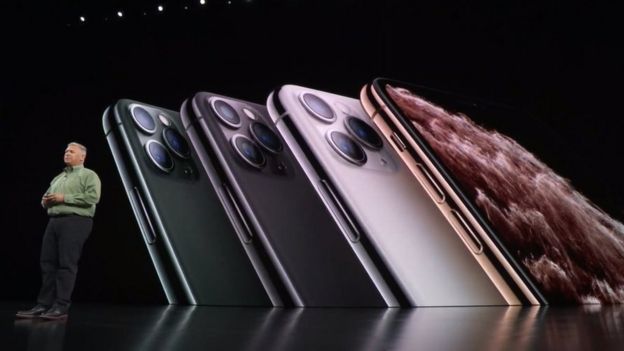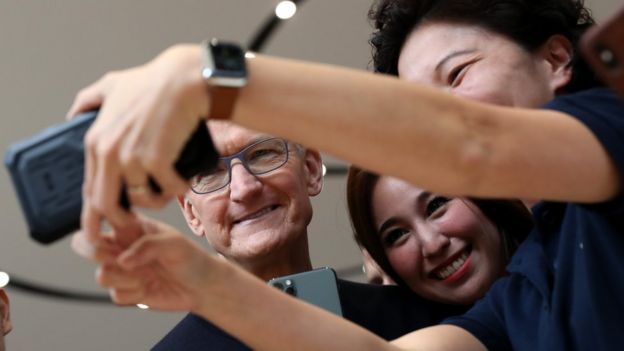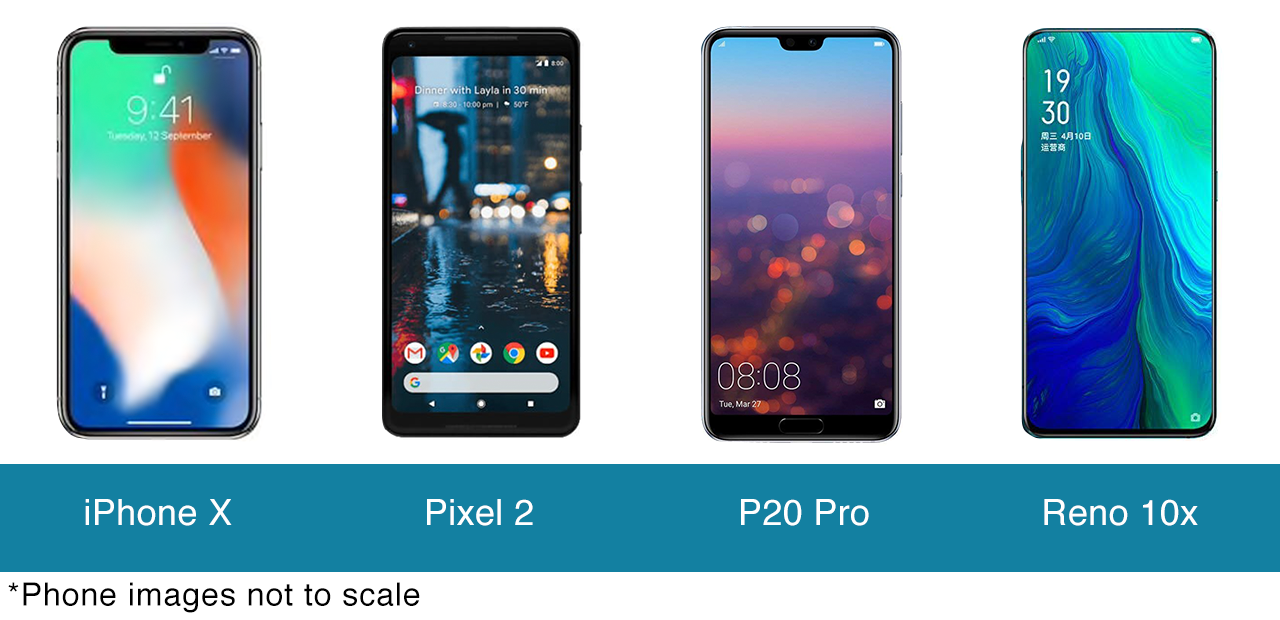Apple’s iPhone 11 Pro and ‘always-on’ Watch unveiled
Apple has unveiled its iPhone 11 range of handsets, which feature more cameras than before and a processor that has been updated to be faster while consuming less power.
The company said the two Pro models would last between four to five hours longer than their XS predecessors.
But it did not launch a 5G model, and some rumoured features were missing.
Apple also revealed a new version of its smartwatch, which features an “always on” display for the first time.
The Series 5 Watch adjusts how often it refreshes the screen to as little as one frame per second as well as dimming the image to promise the same 18-hour battery life as the previous version.

It also introduces a compass as well as the option of a titanium case. Its new operating system will alert owners to when nearby noise rises to risky levels, and adds menstrual cycle-tracking.
“I love strategically where Apple is going with its health and safety capabilities, but was disappointed to not see a sleep study or feature mentioned,” commented analyst Patrick Moorhead.
The company added that it will keep its Series 3 model on the market, which will cost $199 – or £199 in the UK – marking a new entry price point for the wearable.
The news on Apple Watch is less about Series 5 and all about Series 3. At $199 this could be the hook to catch Android users. #AppleEvent pic.twitter.com/ZIPNZeQ6Ik
— Geoff Blaber (@geoffblaber) September 10, 2019
Apple currently accounts for 49% of the global smartwatch market, according to research firm IDC.
It is also the UK’s top-selling smartphone brand by a wide margin.
Camera features
The new iPhones are notable for introducing an “ultrawide” rear camera, offering 2x optical zoom-out.

The Pro models retain the telephoto and normal lenses found in the last generation’s XS and XS Max, while the basic iPhone 11 only has an ultrawide and standard lens.
Apple made a virtue of a new Night Mode, which automatically brightens the image when required while taking steps to minimise the digital noise produced as a result.
Google, Samsung and Huawei had already introduced a similar feature to their handsets.

A new facility called Deep Fusion was also teased. It takes nine snaps with a variety of exposures and then picks through them “pixel by pixel” to combine the best parts from each to create a superior image.
This will not, however, be available at launch but should be added via a software update before the year’s end.
Other enhancements include the ability to shoot slow-motion videos with the front camera.
iPhone 11 Pro’s multi-camera bump is unnecessarily ugly, but looks like it will deliver on vast improvements in imaging. Users will likely be able to live with the trade-off.
— Ken Hyers (@kenhyers) September 10, 2019
The handsets’ processor – the A13 Bionic – has also been upgraded.
Apple claims its CPU (central processing unit) and GPU (graphics processing unit) are more powerful than those featured in any Android phone.
In addition, the chip’s “neural engine” has been optimised to better handle matrix calculations – a type of algebra used by neural networks – and is said to be 20% faster than the A12.
However, the new models are not compatible with Apple’s Pencil stylus, as had been expected by many. That feature was already offered by its lowest-end iPad.
Nor can they wirelessly recharge other devices, unlike Samsung and Huawei’s premium phones.

The handsets also stick with having lightning ports rather than making the shift to USB-C, as has happened with the iPad Pro – which could have made faster data transfers possible.
The iPhone 11 is slightly cheaper than its XR forerunner in the UK, ranging between £729 and £879 depending on the amount of storage.
But the Pro models are more expensive than the XS ones, costing between £1,049 and £1,499.
They go on sale in 10 days time.
Slowing demand
Apple experienced a bigger drop in demand for new handsets than many of its rivals over the past year.
But the firm recently reported that its active install base – the number of iPhones in use – was at an “all time high”.
Global smartphone shipments
| Brand | Devices year-to-June 2019 | Year-on-year change | Global market share in Q2 |
|---|---|---|---|
| Samsung | 290.6 million | -5.5% | 22.9% |
| Huawei (incl Honor) | 230.3 million | 31.8% | 17.7% |
| Apple | 185.9 million | -14.5% | 10.2% |
| Xiaomi | 118.9 million | 2.0% | 9.7% |
| Oppo | 111.9 million | 0.1% | 8.9% |
| Vivo | 106.9 million | 14.4% | 8.5% |
| Others | 329.3 million | -13.6% | 22.1% |
| Total | 1.4 billion | -5.0% | 100% |
Source: IDC
“Several forces play here,” commented Marta Pinto from IDC.
“Apple designs devices that last longer than an average Android device, and it’s been very good at rolling out new versions of its operating system.
“There’s also a very good second-hand trade in iPhones, and the overall smartphone market is slowing down.
“But Apple doesn’t mind because its focus is now turning to services, and its wearables are also doing well.”
The new iPhone line-up does not feature a 5G model, in part because Intel struggled to develop the required modem.

At a time when consumers are holding onto their handsets for longer before upgrading, that could place a further constraint on sales – especially in countries where 5G networks have already launched, such as the UK.
“Given people’s loyalty to iPhone, if they really want 5G they’ll probably just wait,” said Ben Wood from the consultancy CCS Insight.

“That said, don’t be surprised to see rivals, particularly Samsung, positioning 5G devices as ‘future-proof’ options.
“I’m sure they will be arguing that buying a premium priced 4G smartphone right now would be like buying a TV a few years ago that was not HD-Ready.”
Subscription services
Earlier at the event, chief executive Tim Cook revealed that Apple’s two forthcoming subscription services would each cost $4.99 – or £4.99 in the UK – per month.

Apple Arcade – a video games deal offering exclusive access to games that do not feature in-app fees – will become available on 19 September.
Apple Arcade will enhance, rather than transform, Apple’s position in gaming. It already generates vast income by pocketing 30% of App Store transactions.
The rationale behind it seems to be to create a prestige gaming offering, in keeping with the Apple brand #AppleEvent pic.twitter.com/8mdE94SxP9— George Jijiashvili (@GioKinto) September 10, 2019
It will be followed by Apple TV+ – a television programme and movie-streaming platform with content not available elsewhere – which will make its first shows available on 1 November.
The latter will be cheaper than rival services from Disney and Netflix, but appears to promise less material at this stage.
“I applaud web access to Apple TV+, but would have preferred an Android and Windows app,” commented Mr Moorhead.
 Image copyrightAPPLE
Image copyrightAPPLEThere was no mention of Apple bundling the new services with its existing cloud storage, news and music offerings for a discount, as had been speculated.
But it will offer one year’s Apple TV+ membership to consumers buying one of its computers or set-top boxes.
While the price is better than expected Apple TV+ pales in comparison to Disney+. I hope Apple’s expectations are not too high. https://t.co/I6dlWyk1Bx
— Michael Goodman (@MikeGoodman_SA) September 10, 2019
In addition, the company unveiled a new iPad.
The seventh generation model has a 10.2in (25.9cm) screen – making it bigger than before – and will go on sale at the end of the month.
It will start at £349, a £30 increase on the earlier model.
$329 for the #iPad 7gen with smart connector for #SmartKeyboard and support for #pencil will kill any aspiration for those few vendors left in the Android tablet market. Note also that #iPad has become the first device into the Apple ecosystem for many consumers #AppleEvent pic.twitter.com/VHrGTkQWOS
— Carolina Milanesi (@caro_milanesi) September 10, 2019
It has now been nearly 13 years since Steve Jobs unveiled the first iPhone.
Apple has since become one of the world’s most valuable companies, in part because of investors’ hopes that it can pull off a similar trick.
“Everyone wants Apple to have a new ‘wow’ product and its got a pretty good track record,” commented Mr Wood.
“But the next big hit is proving elusive right now. My money is still on smart glasses but I think it could still be years before we see anything.”

These updates are less about bringing in new features, but enhancing the things we’re already familiar with.
The iPhone Pro’s camera setup is being aimed at – as you might guess – professionals. I think Apple sees big potential in indie filmmakers and documentary-makers. The battery-life bump should also help.
Apple TV+ is cheap compared to its competitors. But is it good value?
Disney+, Netflix, HBO et al have huge back catalogues of loved TV shows and movies. Apple doesn’t, or at least it’s not clear what it will have, even one year from now.
All Apple really has is a boatload of cash to fill up Apple TV+ with content it hopes people will like. We’ve seen no evidence, yet, that it’s capable of fulfilling that goal.
Giving one year’s access away with new devices is a way of making sure those new shows have wide exposure – but it needs to convince the entertainment industry that it’s worth making a show for Apple+ instead of its rivals.

How phone cameras evolved:

Kyocera VP-210 VisualPhone (1999)
Although there is some dispute over which mobile first featured a built-in colour camera, many credit this handset as having the honour. It featured a 0.11 megapixel (MP) sensor and could only store 20 selfies, but was able to transmit a jerky video feed in real-time at about two frames per second.
Sharp J-SH04 (2000)
Sharp’s first photo-snapping mobile placed its sensor on the rear of its handset to encourage its use as an alternative to standard cameras. Its 0.11MP snaps could then be sent to friends via email.
Sony Ericsson T68i (2002)
The handset’s optional CommuniCam MCA-20 accessory snapped on to the bottom of the handset, helping keep down the phone’s size when not in use. It was limited to taking VGA (0.3MP) resolution shots, but the images could be texted to others via MMS (Multimedia Messaging Service) if they had compatible phones.
Samsung D500 (2004)
This was one of the first handsets to offer more than one megapixel of image quality. What’s more it had a flash. Meanwhile the software made it possible to add graphical frames around photos and turn images sepia or apply a “negative” effect.

Nokia N90 (2005)
Nokia’s N90 had a somewhat clunky swivel design, but a two megapixel sensor and a lens developed in collaboration with the famed German optics firm Carl Zeiss pitched it firmly at camera enthusiasts.
Samsung G800 (2007)
The megapixel wars were well under way by the time Samsung unveiled the G800. It took 5MP shots, had a 3x optical zoom and even featured a lens-cover slider, meaning that from the rear it could be easily mistaken for a dedicated camera.
iPhone 4 (2010)
Apple’s fourth-generation iPhone is widely credited with helping kickstart the selfie craze, despite being far from the first to have a front camera. But at its launch, Steve Jobs was keener to show off how the feature could be used for Facetime, the firm’s video chat app.
LG Optimus 3D (2011)
Smartphones with two rear cameras were still a rarity when LG’s Android phone went on sale. It used them to create 3D images that could be viewed without special glasses on its display. But 3D phones proved to be as unpopular as 3D TVs, marking an evolutionary dead end for the industry.

HTC One (2013)
HTC’s 2013 flagship sought to shift the battle to low-light photography. To do this it made the pixels larger than normal to gather more light, and dubbed them “ultrapixels”. The trade-off was that its photos were limited to 4MP.
Nokia Lumia 1020 (2014)
This Windows Phone featured an industry-leading 41MP sensor attached to an optical image stabilisation system. It allowed users to zoom in and crop without worrying about images becoming blurred, or to combine the data to make 5MP photos with less visual noise than would otherwise be the case.
Lenovo Phab2Pro (2016)
This was the first handset to build in Google’s doomed Project Tango depth and motion-sensing cameras. They made augmented reality features possible, such as superimposing graphical images of furniture into views of a room. Tango was short-lived, but AR has lived on by other means.
Samsung Note 8 (2017)
This was one of the first phones to feature “live focus” – a facility that allowed users to adjust background blur in their photos before or after taking them. It achieved this by comparing the view from each of its two rear cameras to create a depth map of the scene.

iPhone X (2017)
Apple’s tenth anniversary handset introduced its Face ID camera system, which used tens of thousands of infrared dots to map the user’s features. As a consequence, the display had to make space for a “notch”, which was widely copied by rivals even if they didn’t feature such an elaborate facial recognition system.
Pixel 2 (2017)
Google found a way to let users blur the background of their photos using a single camera in its second-generation Pixel. This made it possible to offer the effect from both its front-facing selfie camera as well as the rear sensor.
Huawei P20 Pro (2018)
The Chinese firm’s phone was one of the first to feature three cameras on its back. But the standout feature was its ability to produce quality snaps in near-dark conditions by taking long-exposure snaps and then using machine learning software to keep the details crisp.
Oppo Reno 10x Zoom (2019)
This had two unusual camera features. Firstly, one of the rear cameras has a periscope design that directs light sideways into the device’s body, making it possible to let users zoom into a shot more than usual without sacrificing detail. Secondly, the selfie camera pops up from the top, making more space for the display.





